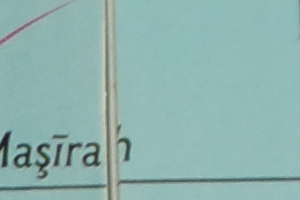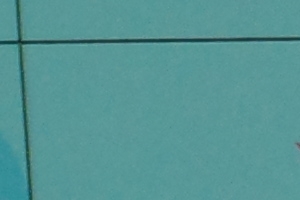Pentax DA* 50-135mm F/2.8 SDM Review
Introduction
The Pentax DA* 50-135mm F/2.8 SDM is a professional-grade medium telephoto zoom lens for APS-C DSLRs. This bright constant-aperture zoom covers the same range as a classic 70-200mm Full-Frame lens while being significantly more compact since it only requires to project an APS-C imaging-circle. This focal-range is rarely produced from lens manufacturers.
Pentax introduced DA* professional lenses in early 2007 with the Pentax DA* 50-135mm F/2.8 SDM plus the Pentax DA* 16-50mm F2.8 ED AL (IF) SDM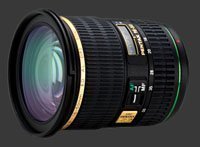
Pentax DA* 16-50mm F2.8 ED AL (IF) SDM. These were the first weatherproof K-mount lenses on the market. At the same time, Pentax launched their first ultra-sonic motor knowns as SDM within both these lenses.
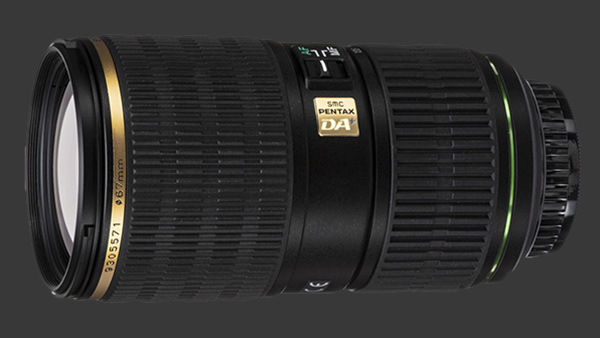
Even though Pentax created more lenses that cover a broader focal-range, this is the only one with a constant maximum aperture and the only one that opens to F/2.8. The DA* 50-135mm F/2.8 SDM was an instant success. It became widely used for portraiture and street-photography. Even though third-party lenses for K-mount exist, none matches the specifications of this telephoto lens.
This telephoto zoom lens captures a 12-32° angle-of-view that renders a flattering perspective for portraits and compresses scenes which is highly practical in street photography. Its combination of bright aperture and telephoto reach allow it to produce images with very shallow depth-of-field which greatly helps isolate subjects. Although it is labeled SDM, the DA* 50-135mm F/2.8 SDM also features screw-drive autofocus.
Design & Build Quality
The Pentax DA* 50-135mm F/2.8 SDM came with a unique optical design tuned to deliver the highest-quality images from an APS-C DSLR at the time. The result is a dense lens with completely internal zoom and focus systems packed inside a weatherproof and freezeproof body. Its 18 optical elements arranged in 14 groups make is heavy for an APS-C lens yet is noticeably lighter than any equivalent Full-Frame lens.
The telephoto lens is nearly perfectly cylindrical with a 77mm diameter. Towards the lens mount, it becomes a few millimeters less wide yet it is barely noticeable. The lens body is extremely solid and assembled with really tight tolerances. It weighs a hefty 685g, plus an extra 80g for a deep petal lens hood.
There is a nice smooth finish on exposed parts of the lens barrel. About two centimeters of it appear between the extremely broad focus-ring at the front and the large zoom-ring at the back. Since focus and zoom mechanisms are internal, there is no extending inner barrel on this lens. The mechanically-lined focus-ring at the front rotates smoothly without limits or stops. Focus can be pushed passed infinity this way to correct for potential glass expansion or contraction due to the ambient temperature.
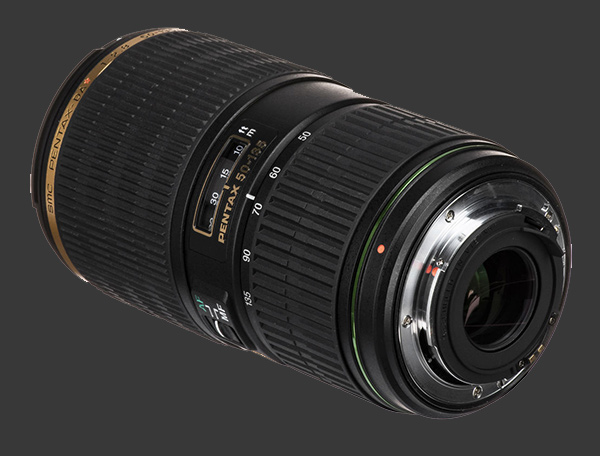
A simple AF/MF switch on the side of the lens barrel has a nice firm detent. On top of the lens along the barrel ring that as the focus-switch, there is a focus-window that shows the currently set focal-length. Unlike with some designs, the focus-distance shown is always accurate since it changes in both AF and MF modes.
A large zoom ring towards the lens mount has a 45° throw to set focal-length. It rotates extremely smoothly which allows for precise adjustments. There are hard stops at 50 and 135mm, plus markings at 4 intermediate points at regular angular-intervals. The zoom ring is coated in a highly textured rubber coating, making it easy to operate while wearing gloves.
Pentax fit their DA* 50-135mm F/2.8 SDM with a KAF2 lens mount which offers mechanical aperture and focus links, plus electronic contacts that control aperture and focus using the SDM motor. Autofocus defaults to the SDM system, unless the camera only has a KAF mount. It is possible to modify the firmware to always select screw-drive autofocus though.

Dual autofocus systems inside the Pentax DA* 50-135mm F/2.8 SDM were intended to allow a smooth transition from traditional screw-drive autofocus lenses to modern ultra-sonic ones. This shows how much Pentax was interesting their existing customer-base. It also saved them from a potential fiasco when SDM motors started failing at an alarming rate, particularly first-generation ones launched in this DA* 50-135mm SDM and the DA* 16-50mm F/2.8 SDM. The SDM motors frequently died after only a few years yet the screw-drive link stood the test of time. It also allowed for faster AF when fitted on newer cameras.
The front of the lens accepts 67mm screw-on filters. This is one of the most common and affordable filter sizes among all brands. Pentax created a custom petal lens hood for this lens with a large removable window. Once removed, this window gives access to the lower edge of the mounted filter which is extremely convenient when mounting a polarizer that requires rotating.
Image Quality & Autofocus Performance
Pentax designed a new optical formula for the DA* 50-135mm F/2.8 SDM to match the ultimate resolution at the time and provide room for higher-resolutions in the future. Back in 2007, the highest resolution Pentax DSLR offers 10 MP, while competitors offers 12 megapixels. The result is a lens that produces legendary results with contemporary cameras and remains reasonable on modern 26 MP DSLR that capture 160% more resolution!
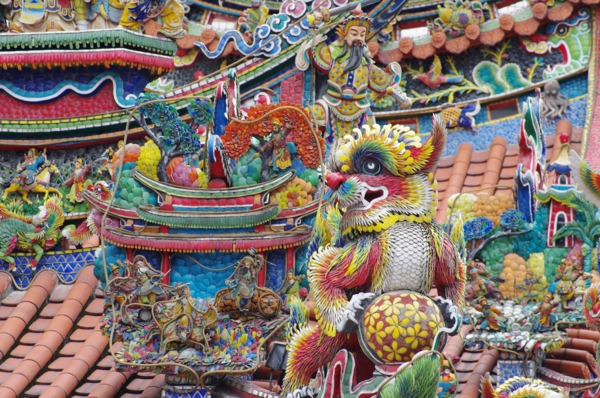
It is significantly easier to produce a telephoto lens than a wide-angle one without distortion. Unsurprisingly, the DA* 50-135mm F/2.8 SDM shows virtually no discernible distortion at any focal-length. Also completely absent from images at any aperture is vignetting. The geometry of this lens is exemplary.
This constant-aperture telephoto zoom is also highly resistant to flare and chromatic aberrations. There can be some slight purple fringing right on an edge of extreme contrast yet camera firmware removes this very effectively these days, so it is unlikely to appear in photos. This lens produce fairly good contrast. Its output is not as crisp as that from lenses with modern nano-crystal coatings.
Pentax DA* 50-135mm F/2.8 SDM Sharpness
Sharpness from this lens varies greatly along edges yet the center is always sharp. Towards the wide-end of the zoom, images are very sharp in the center, even fully open. Stopping down just a half-stop makes the center razor sharp until the point where diffraction appears, around F/9.5. The review until of this lens is slightly decentered which make upper corners softer than lower ones. Wide-open, all corners appear soft at wide-angle. While upper corners took all the way to F/8 to sharpen, lower corners became fairly sharp at F/4. They improved at F/6.7 but never become perfectly sharp.
Around middle focal-lengths, the center of images captured by the Pentax DA* 50-135mm F/2.8 SDM is razor sharp even wide-open. Stopping down maintains this perfect sharpness until F/9.5. Corners appear soft at F/2.8 but they sharpen up quickly. F/4 produces very usable corners Closing the aperture more to F/5.6 results in very sharp corners all around.
The long-end of this zoom shows similar results to its wide end. The center is fairly sharp wide-open then and becomes very sharp at F/3.5 and beyond. Corners are all soft wide-open which improves slightly with every fractional aperture beyond that. Unlike the wide-end, corners at this long focal-length never become sufficiently sharp to make very large prints.
What is shown below are 5 crops taken from a photograph, repeatedly captured for each combination of focal-length and aperture. The smaller pieces are cropped from the extreme corners of the image, while the middle wide crop comes from the center of the image. Select an aperture in a row for a desired focal-length to see the crops from the corresponding image. When judging quality, keep in mind that these crops come from a 26 MP image which is normally used to print an image up to 30x20". On a computer display, these may appear much larger which magnifies image defects.
The above interactive crops really show the difference between extreme corners to the center and how it varies according to aperture. Stopped down at F/5.6 and beyond, this lens produces sufficiently detailed images. There is clearly a loss of image-quality near corners that was not anticipated in 2007. For typical print-sizes though, the difference is much harder to note than in these 100% crops.
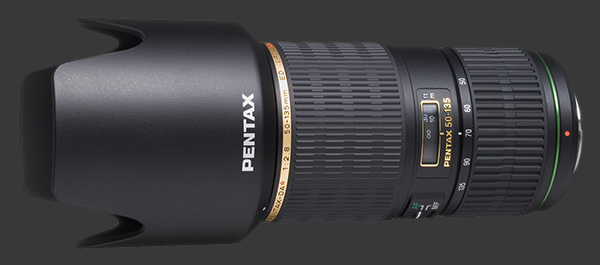
Autofocus Performance
The struggles of SDM motors are real. The autofocus speed of this lens is all-over-the-place. Many times, it focuses quickly and quietly, particularly with more distant subjects. It is typical to get AF lock in under a half second. Other times, one can see focus move slowly towards its subject. The screw-drive motor proves a much more consistent experience. It is slower and, on average, faster than SDM.
While this lens can be used with success with moving subject, it is too inconsistent to recommend for sports other types of photography where timing is essential. For the occasional moving subject or street photography where one often prefocuses at a certain distance, then it is capable. For portraits, subject moves yet generally very little and so this lens can manage to track sufficiently well.
Conclusion
The Pentax DA* 50-135mm F/2.8 SDM shows it is capable of capturing great images even though it was designed more than 15 years ago. While it does not offer the optical quality of modern lenses, it provides a unique proposition for Pentax APS-C DSLR users. It remains the lightest and smallest bright telephoto zoom within the Pentax lineup.
Image quality from this lens is good. Away from its extreme focal-lengths, captured images appear very sharp in the center regardless of aperture and are completely sharp stopped-down by one or more stops. Near both the widest and the longest focal-length, it only takes a little stopping down to get a sharp center but a smaller aperture is required to obtain acceptable corners.
There is essentially nothing to say about vignetting or distortion, either are simply not there. Color, contrast, flare and chromatic aberrations are also extremely well controlled. Optically, this is a rather good lens. This zoom is also extremely tough and has an outstanding weatherproof and freezeproof body.
Autofocus can be quick yet the builtin SDM motor is unreliable. Luckily, it is possible to reprogram the firmware of this lens to operate by screw-drive autofocus which delivers a much more consistent experience. It is fractionally slower than when the SDM motor responds well but infinitely better when it stalls.
Pentax makes four constant-aperture telephoto lenses, each with its own advantages. The DA* 50-135mm F/2.8 SDM is the oldest yet also the smallest and lightest. Next up is the Pentax HD D FA 70-210mm F/4 SDM WR that shifts the focal-range further while giving up a full-stop of brightness. This is the most probable lens other lens to consider since it is only135g heavier. It definitely leaves a gap between either DA* 16-50mm F/2.8 lenses and itself but so is the case for the two remaining contenders. Next up is another old lens which is unfortunately also prone to SDM failure, the Pentax DA* 60-250mm F/4 SDM. For another 200g more, this 60-250mm lens has the widest focal-range in the group. Finally, and only if weight is not a consideration, there is the Pentax HD H FA* 70-200mm F/2.8 DC AW which weighs in 3X more while offering Full-Frame coverage.
The Pentax DA* 50-135mm F/2.8 SDM offers a unique combination of focal-range and aperture that is very attractive for APS-C cameras. Its image quality is sufficiently good for most uses and it is really built to last, with the exception of its SDM autofocus motor. Luckily, a secondary screw-drive motor is available which makes this lens recommendable. There is currently nothing that complete telephoto coverage within the Pentax APS-C lens lineup quite like the DA* 50-135mm F/2.8 SDM.
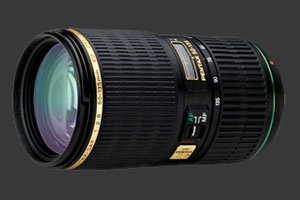
Please Support Neocamera
All information on Neocamera is provided free of charge yet running this website is a huge endeavor. Purchases made via affiliate links found throughout the site help keep it running and up-to-date. There is no additional cost to you, so please consider buying via these links to our affilates:
If you found any information on this site valuable and did not purchase via our affiliate links, please considering donating via PayPal:
Any amount will be greatly appreaciated. Thank you for your support!
Updates
2024.11.18

Best 2024 Photography Gifts for Every Budget
Great gifts for photographers and photo enthusiasts selected for every budget among the best products of 2024.
2024.08.07

Eye Protection Tips for Professional Photographers
The four main considerations for professional photographers regarding eyewear.
2024.07.14

Fujifilm X100VI Review
Flagship fixed-lens compact digital camera with a 40 MP sensor and Image-Stabilization, a first for the series. Retro design featuring dual control-dials, plus direct ISO, Shutter-Speed and EC dials. Its hybrid viewfinder can switch between EVF and OVF mode.
2024.05.09

Fujifilm GFX100 II Review
Flagship 102 Megapixels Medium-Format Mirrorless Digital Camera with 8-Stop 5-Axis IBIS, 8 FPS Drive, 8K Video and 400 MP Super-Resolution capture in a weatherproof and freezeproof body with dual control-dials and dual memory-card slots.
2024.04.03

Fujifilm X-T5 Review
Newest Fujifilm flagship boasting a 40 MP APS-C sensor, 5-axis IBIS with 7-stop efficiency, 15 FPS continuous drive, 6.2K Video capture, dual control-dials and dual SDXC UHS-II slots in a sturdy weatherproof and freezeproof body.
2023.11.20

Best Digital Cameras of 2023
Find out which are the Best Digital Cameras of 2023. All the new Mirrorless Digital Cameras from entry-level to high-end professional.
2023.07.10

Fujifilm X-H2 Review
40 Megapixels APS-C Hybrid Mirrorless Digital Camera with 7-stop IBIS. Fastest shutter ever and 8K video capture. Large builtin EVF with 0.8X magnification and 5.8 MP, plus an Eye-Start Sensor. Packed with features and large number of controls in a weatherproof and freezeproof body.
2023.05.07

Sony FE 20-70mm F/4G Review
Review of the unique Sony FE 20-70mm F/4G lens. The optical zoom of this lens spans ultra-wide-angle and medium focal-length coverage, making it one of the most versatile Full-Frame lenses on the market.
2023.01.15

Huion Inspiroy Dial 2 Review
Review of the Huion Inspiroy Dial 2 tablet, a medium sized drawing surface with dual dials and customizable buttons. Connects via USB-C or Bluetooth 5.0 with Windows, Linux and Android support.
2022.12.08

How to Pack for a Photo Trip
Find out how to pack for a travel photography trip, carry your gear safely while meeting airline regulations.
2022.11.13

Best Digital Cameras of 2022
The best digital cameras of 2022. A short list of the most outstanding models in their respective categories. Choose one for yourself or as a gift.
2022.09.21

Pentax DA* 60-250mm F/4 SDM Review
Review of the Pentax DA* 60-250mm F/4 SDM, the constant-aperture telephoto zoom with the highest zoom-ratio on the market.
2024.11.18
2024.08.07
2024.07.14
2024.05.09
2024.04.03
2023.11.20
2023.07.10
2023.05.07
2023.01.15
2022.12.08
2022.11.13
2022.09.21
NEWS
2024.12.17

Venus Unveils 2 Tilt-Shift Macro Lenses
Lens
2024.12.17

Panasonic Lumix G97 and ZS99 Launched
Digital Camera
2024.11.19

Sony Unveils Their Brightest Zoom Lens
Lens
2024.11.19

Sony Finally Upgrades Alpha A1 Flagship Camera
Digital Camera
2024.11.12

New Laowa Slim Ultra-Wide Lens
Lens
2024.11.07

Hasselblad Adds XCD 75mm Lens
Lens
2024.11.07

Nikon Launches Z50 II
Digital Camera
2024.11.05

Venus Created Worlds First Shift Zoom Lens
Lens
2024.11.01

Nikon Announces Development of Standard Power-Zoom Lens
Lens
2024.10.30

Canon Launches 3D APS-C plus 3 Extra RF Lenses
Lens
2024.10.14

Fujifilm Extends APS-C Lineup
Digital Camera ○ Lens
2024.09.27

Leica Launches New Q3 with 43mm Lens
Digital Camera








